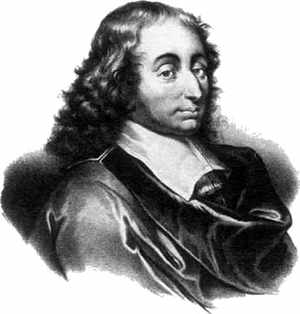Blaise Pascal
Mechanical aids to calculating, such as the abacus or counting frame have been used for thousands of years. The first real calculating machine (i.e. one where the result or total could be read off directly) was devised by Blaise Pascal in 1642. Pascal originally designed it to help his father in his work of adding and subtracting money. Several machines were built using the same principle. The one described here is dated 1652, and the original is to be found in the Conservatoire des Arts et Metiers in Paris. A copy can be seen in the Science Museum, London.
Pascal’s machine embodies many of the principles still used in calculators. It consists of a box containing six sets of pinwheels and cylinders. Each cylinder bears the figures 0-9 around its edge, and is so arranged that only one figure – equivalent to of the circumference – can be seen through the sighthole at any given time. The pinwheels are connected to the six horizontal dials (rather like a telephone dial and marked from 0-9) at the front, so that when the dial is turned, the corresponding pinwheel and the cylinder turn with it.
To follow the method of using the calculator, suppose that the operator wishes to add together the numbers 2, 5 and 3. With a stylus or peg he turns the right hand dial anticlockwise from where the figure 2 is marked round to 0. The dial moves in the opposite direction to the dial on a telephone and it does not spring back to its starting position when the peg is removed. This action turns the pinwheel and hence the cylinder of a revolution from 0-2. The operator now repeats the process, this time ‘dialling’ 5. The pinwheel turns the cylinder a further of a revolution, so that the total registered there is 7. Once again he dials a number, in this example number 3. The pinwheel moves through of a turn, as does the cylinder. Because the cylinder is marked in tenths, however, and ten units have been added (2+5+3), this brings it round to 0 again. A trip-mechanism within the calculator, however, ‘carries’ the figure 1 to the cylinder immediately to the left, i.e. it turns the next wheel of a revolution, from 0 to 1. There are six cylinders altogether, which represent (from right to left) single figures, tens, hundreds, thousands, ten thousands and hundreds of thousands respectively. The adding of the singlefigures 2,5 and 3 gives 0 in the single figure cylinder and 1 on the tens cylinder, thus producing the answer total 10. With the six cylinders sums can be added up to a total of 999,999. In face the model described has two sets of numbers on the ‘dials’ and the cylinders, the second set running in the reverse direction (i.e. from 9-0 instead of 0-9). The latter can be used for subtraction, and are covered up on the cylinders by a sliding strip of metal when not in use.
Some of Pascal’s machines were designed for adding livres, sous and deniers (the contemporary French equivalent of our pounds, shillings and pence), and may be regarded as the forerunners of modern cash registers.
Although his invention of the calculating machine is important, Pascal is not thought of primarily as an inventor. His work ranged over physics, mathematics and philosophy. Born at Clermont-Ferrand in 1623, Pascal became interested in mathematics at an early age. He is reputed to have worked out for himself at the age of 12 many of the geometrical ideas of Euclid. He constructed his first calculating machine before he was 20. A few years later he was able to show, by experimenting with barometers, that the pressure of the atmosphere decreases with altitude.
Pascal’s machine
Pascal is remembered nowadays, some 300 years after his death, through Pascal’s Law of fluid pressure and Pascal’s Triangle. The law of fluid pressure which resulted from his work on hydrostatics underlies the action of hydraulic jacks, hydraulic presses and similar machines. Pascal’s Triangle is a well known pattern of numbers which is used in the studies of chance and probability.
The extent of Pascal’s work is all the more striking in view of the fact that he suffered form poor health all his life and that he was only 39 when he died in 1662.


No comments:
Post a Comment